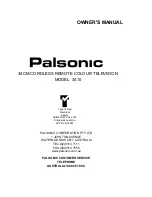
Troubleshooting
Speci
fi
cations
If a problem occurs when you are using the TV, check the below trouble-
shooting guide before calling for repair.
Problem
Cause / Solution
No or poor picture
• Turn OFF BLUE BACK if it is ON. (
\
page 5)
• Adjust the COLOUR or BRIGHT setting. Refer to
“PICTURE SETTING”. (
\
page 5)
• Choose the appropriate colour system. (
\
page 5)
Snowy picture
• Check the aerial and TV connections. (
\
page 3)
Stripes or coloured
patches appeared
• Interference caused by electrical appliances or
speakers. Move them away from the TV.
Double-picture
(ghosting)
• Interference caused by signal reflecting from mountains
or buildings. Adjust the aerial’s direction or use another
antenna.
No or poor sound
• Choose the appropriate sound system. (
\
page 5)
White and bright still
image looks as if it is
coloured
• Inevitable phenomenon due to the nature of the picture
tube. This is not a malfunction.
Image from video input
is distorted
• The image was not properly recorded. This is not a
malfunction.
Cannot operate the
remote control
• Replace the batteries. (
\
page 2)
• Operate it at less than 7 meters from the TV.
Cannot operate the
MENU
• Exit and enter the MENU again.
Cannot operate the
front panel buttons
• Turn OFF CHILD LOCK if it is ON.
Image takes a while to
be displayed
• Image requires time to stabilize before display.
This is not a malfunction.
TV emits crackling
sound
• Caused by a sudden change in temperature and it is not
a malfunction. Call a service technician for inspection.
Static shock when
touch the TV screen
• Caused by static electricity of the picture tube and it will
not harm the human body. This is not a malfunction.
The TV turns off
suddenly
• This is not a malfunction. If you had set the BLUE
BACK function to ON, TV will be turned off automatically
when no signals are received from an antenna for about
15 minutes or longer.
© 2007 Victor Company of Japan, Limited
0307SCT-NF-MT
TV RF systems
B, G, I, D, K
Colour systems
PAL, SECAM, NTSC 3.58 MHz / NTSC 4.43 MHz
(in VIDEO mode only)
Receiving
channels
VHF low channel (VL), VHF high channel (VH), UHF channel (U)
Receives cable channels in mid band, super band and hyper band.
Power
requirements
AC 160 to 240 V, 50 Hz / 60 Hz
External input / output
INPUT
VIDEO input, AUDIO input
OUTPUT
VIDEO output, AUDIO output
Headphone jack
Stereo mini jack (3.5 mm diameter)
Design and speci
fi
cations are subject to change without notice.
GGT0144-001B-H-EN.indd 8
GGT0144-001B-H-EN.indd 8
23-02-07 10:26:18
23-02-07 10:26:18

































